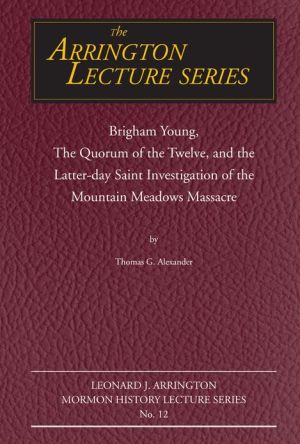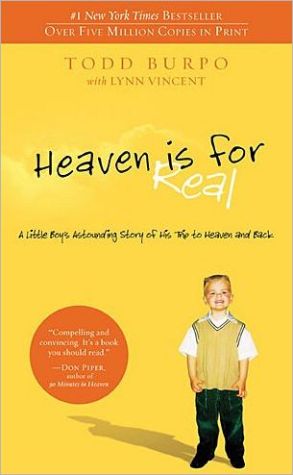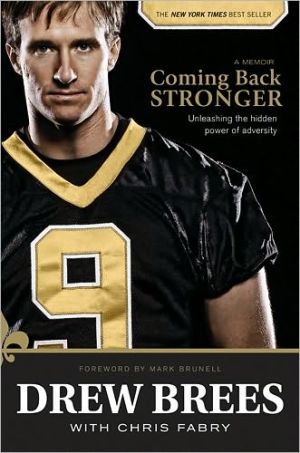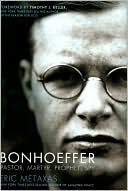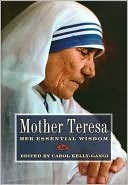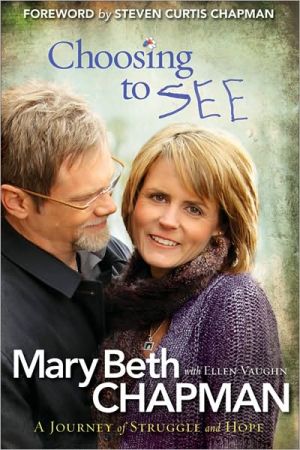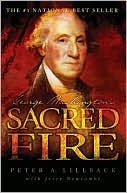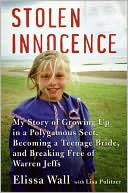Brigham Young, the Quorum of the Twelve, and the Latter-Day Saint Investigation of the Mountain Meadows Massacre: Arrington Lecture No. Twelve
On September 11, 1857, a wagon train of emigrants passing through the Utah Territory on their way to California were massacred at Mountain Meadows. Although today’s historians agree that the principal perpetrators were members of the Mormon militia in southern Utah, how much the central Mormon leadership, especially Brigham Young at the top, knew about the massacre, when and how they learned about it, and the extent of a cover up afterward are still matters of controversy and debate.\ In this...
Search in google:
On September 11, 1857, a wagon train of emigrants passing through the Utah Territory on their way to California were massacred at Mountain Meadows. Although today’s historians agree that the principal perpetrators were members of the Mormon militia in southern Utah, how much the central Mormon leadership, especially Brigham Young at the top, knew about the massacre, when and how they learned about it, and the extent of a cover up afterward are still matters of controversy and debate. In this 12th volume of the Arrington Lecture Series, Thomas Alexander (Lemuel Redd Professor of Western American History, Emeritus, at Brigham Young University), asserts that Brigham Young and the LDS Church’s governing Quorum of Twelve made timely and diligent efforts to investigate the massacre and encouraged legal proceedings but were hindered by federal territorial officials and lied to by massacre participant John D. Lee, preventing Young from learning the full truth for many years.
Brigham Young, The Quorum of the Twelve, and the Latter-day Saint Investigation of the Mountain Meadows Massacre\ \ By Thomas G. Alexander \ Utah State University Press\ Copyright © 2007 Thomas G. Alexander\ All right reserved.\ ISBN: 978-0-87421-687-5 \ \ \ Chapter One\ Brigham Young, The Quorum of the Twelve, and the Latter-day Saint Investigation of the Mountain Meadows Massacre \ As early as May 29, 1857, Utahns had begun to believe their lives stood in peril. Word seeped in that President James Buchanan had dispatched an army of two to three thousand troops "to the Territory." Throughout the summer, Brigham Young, as incumbent governor of Utah Territory and president of the Church of Jesus Christ of Latter-day Saints, met in council to discuss the pending military invasion with various civic and church leaders, including members of the Quorum of the Twelve, his counselors, Territorial Delegate John M. Bernhisel, and Salt Lake businessman Feramorz Little. On July 12, after meeting with Little, Young wrote that he wished "to avoid hostilities with the United States," but would "draw my sword in the name of Isreal [sic] God" before he would "See this people Suffer as they have done heretofore." In a dramatic confirmation of previous intelligence, Abraham O. Smoot, Judson Stoddard, Porter Rockwell, William Garr, and Elias Smith rode into the Twenty-fourth of July celebration in Big Cottonwood Canyon. They told those assembled that the administration had cancelled Utah's mail contract and ordered twenty-five hundred troops to Utah. The couriers reported that throughout the United States a "feeling of Mobocracy is rife," and "the constant cry is kill the Mormons." Defiantly, Young responded "Let them try it." Confirmation of the impending invasion did not change the plans the territorial leadership had begun to formulate. During the spring and summer of 1857, the community leaders met in council. We should understand that the LDS church functioned as what John Gunnison called a "theo-democracy," not as a dictatorship of Brigham Young or anyone else. As such, the central leadership or general authorities left considerable leeway for local initiative in most matters while conducting periodic investigations to assist in solving problems, gathering information, and offering counsel and, when they believed conditions required, releasing, disfellowshipping, or excommunicating offenders. Since the church was a theo-democracy, local Saints could oppose unpopular policies, and in certain critical conditions, they forced the leadership to change or abandon such programs and policies. Meetings on the pending invasion included members of the Twelve, Young and his counselors, and people with information. Together they made plans to contend with the army. Their plans included recalling missionaries and settlers from outlying regions, calling for assistance from outside Utah, seeking allies, alerting the church membership to prepare for the invasion, and evacuating Utah settlements, if necessary. As the leaders mobilized the community for war, Young and others criticized some local gentiles (as Mormons and non-Mormons called non-Mormons in the nineteenth century) while attempting to maintain good relations with others of them. For example, Young leveled a blistering attack on Charles Mogo, a deputy U.S. Surveyor who came under serious criticism from the Latter-day Saint community for his work. After Mogo wrote a letter explaining his point of view, Young responded with a letter of apology. Later investigations by federal officials showed that the surveyors had conducted shoddy surveys which had to be redone. Young also achieved some success in reining in Mormon hoodlums who started using the martial preparations as a license to prey on non-Mormons. On August 19, he "took measures" to stop "Some men" who were causing trouble with non-Mormon business people. Commenting on his policies, Young said he intended "to give my enemies fair warning." He wrote, "I wish to meet all men at the judgment Bar of God without any to fear me or accuse me of a wrong action." The diary entry is a bit unclear, but the latter comment may have referred to a possible fight with the army. Prudently, in view of the relative poverty and weakness of the Mormon community compared with the rest of the United States, he sought allies. He exchanged correspondence with Pennsylvania aristocrat Thomas L. Kane, a prominent political figure sympathetic to the Mormons but associated with President James Buchanan, a fellow Pennsylvanian. Though he made friends with some non-Mormon merchants like William Bell, he realized that he could expect little tangible support from them or from most Euro-Americans outside the Latter-day Saint fold.\ In planning for Utah's defense, Young and other leaders understood the antagonism that existed between American Indians on the one hand and overland emigrants and the army on the other. Young deplored the indiscriminate killing of Indians. In spite of building settlements on Ute, Shoshone, Goshute, and Paiute lands and frequently fighting battles with these peoples, the Latter-day Saints continued to view the Indians as children of Israel and fellow citizens of God's kingdom. Given Mormon belief in American Indians' descent from the House of Israel, it is not surprising that church leaders and members sought and expected to cement an alliance with them. The information that the Mormons received led them to believe that they could hold the army at bay but that doing so would lead to an extended siege of their intermountain kingdom. To prepare to feed the community during the anticipated siege, Young broke with his previous policy of discouraging Indians from raiding emigrant trains. He sent Dimick Huntington and other emissaries to encourage Indians to steal cattle on the northern and southern overland routes. He expected to store stolen livestock and local grain in the mountains to feed the Euro-Americans and the Indians during the starving time that they expected to accompany the siege. On September 1, he and other leaders met with a group of Pahvant Ute and Paiute leaders to encourage this policy. Recognizing that Young had previously counseled Indians to promote good relations with emigrants, some Indians commented that his advice constituted a reversal of former policy. Young justified the change on the ground that Utahns, whites and Indians alike, needed to store food for the prospective siege. Armies have frequently lived off the bounty of their enemies. Alexander the Great fueled his march to Babylon and India from local populations, and William T. Sherman used a similar tactic in his campaign from Atlanta to Savannah in November and December 1864. A dearth of food and water has often forced besieged people to capitulate to the enemy. To avert this possibility, church leaders intended to feed the besieged people in part with cattle taken from overland emigrants.\ In order to secure the cattle, Young meant to rely on Numic allies. These included the Utes, Shoshones, Gosiutes, and Paiutes. With the exception of some Pahvant Utes, however, most of the other groups, including other Utes, generally declined to ally themselves with the Mormons. On the other hand, the cattle-theft policy succeeded partly with some Southern Paiutes who lived in close proximity to southern Utah communities, such as Cedar City, Harmony, Washington, and Santa Clara. We should understand that some Numic people had engaged in livestock theft during periods of intense overland migration. For many American Indians, such activity seemed small recompense for the use of their lands and resources. Such theft had become most intense outside areas of Mormon influence, particularly on the northern overland trail from City of Rocks to the Humboldt Sink. Prior to September 1857, the Mormons had relied on secondhand information about the plans of the United States Army. On Tuesday, September 8, however, Capt. Stewart Van Vliet came to Salt Lake City to purchase supplies for the army. Offering to furnish nothing but lumber to the troops, Young liked the young officer, but he reemphasized his disdain for and fear of the Buchanan administration and the army. Then, in a startling turn of events, as the leaders met in council on Thursday, September 10, James Haslam entered the meeting, bringing a letter from the Cedar City stake president, Isaac C. Haight. Haight asked whether they should chastise the Baker-Fancher Party. Figuratively hitting the ceiling, Young responded with orders to allow the party to pass, forbidding Haight to interfere with subsequent parties and castigating him for effectively declaring martial law. Young told Haslam that the party had a "perfect right to pass." Perhaps referring to his Indian policy, however, he wrote that the "Indians we expect to do as they please." Some commentators have argued that Young already knew about the plans for the massacre and that, indeed, he had ordered it. Federal Judge John Cradlebaugh and Bvt. Major James H. Carleton believed that they had found evidence of Young's culpability in statements from Paiute chiefs Jackson and Tonche who said that an Indian interpreter from Salt Lake named Huntington had brought a letter from Young telling them that they should help massacre the emigrants. Jackson also told Carleton that Lee and Haight had led the massacre. The letter, if it ever existed, has disappeared, no corroborating evidence has appeared for Carleton and Cradlebaugh's statements, and it is doubtful that their Paiute informants could then read English. Moreover, Haight did not arrive at the meadows until Saturday morning, after the massacre had taken place. In addition, Jackson also said that although John D. Lee "was there," as they were, like them, he refused to participate in the massacre, "being, like themselves, afraid." Jackson also blamed Lee for the death of his brother at Mountain Meadows. In 1866, Judge John Titus reportedly collected "false affidavits," connecting Young to the massacre. Significantly, contrary to authors who have insisted that the interview with Van Vliet changed Young's policy, the young officer's visit actually reinforced Young's previous plans. On Sunday September 13, he gave a stinging tabernacle address in Van Vliet's presence. Afterward, Young and other leaders met with Van Vliet, again emphasizing their fear of the army. Young told him that the Utahns "would ... have received their governors & [civil] officers if they had sent them here without an Army." He said he believed that the army would hold the Mormons captive "while others run their red hot Iron into us & then kill us." Because of this prospect, he said, "we will not have neither their soldiers Armies no[r] officers any more here at all." Reinforcing these plans, after four days of discussions with Van Vliet, Young wrote letters to church leaders in the eastern United States, Canada, and Europe emphasizing the alliance with the Indians-"cousin Lemuel," he called them-and urging lay members and missionaries to gather to Utah with their weapons. When they arrived, Young wrote, the Saints must build up a defense against the army and prepare to abandon settlements and retreat to siege quarters if necessary. Then on September 14, the day that Van Vliet left, Young met again in council with Heber C. Kimball, Daniel H. Wells, members of the twelve, "& several others." The council adopted a proclamation of martial law that they dated September 15. The cover letter sent to local leaders with the proclamation reiterated the need to prepare to abandon settlements and to give emigrant trains passes and let them travel in peace. Within a week, however, he began to hear that a terrible tragedy, contrary to his instructions, had taken place in southern Utah. On September 20, Ute chief Arapeen, brother to the late chief Wakara, stopped to see Young. He told the Mormon leader "that the Piedes had killd the whole of a Emigrant company & took all of their stock & it was right." On September 28, Leo Hawkins, a clerk in the Church Historian's Office, recorded that "reports reached town that the companies of Cala[fornia] Emigrants" consisting of "100 men & 1000" cattle "were all used up by the Indians" at Mountain Meadows. On September 29, John D. Lee arrived in Salt Lake City where he met with Young and Apostle Wilford Woodruff. The story he told partly confirmed Arapeen's account and Hawkins's report. In Lee's case, however, he told Young that he had come to the site after the massacre and helped bury the emigrants. Young came to work at 7 a.m. that morning, but Lee's story of blood and gore apparently so sickened him that at 11 a.m. he had himself driven to his upper mill at the mouth of Parley's Canyon, "his health being feeble." In 1870, Lee insisted that he had told Young the truth except for "one thing." He insisted that in reporting to Young he had assumed responsibility for the massacre himself. In 1876 and afterward, either Lee or his attorney, W. W. Bishop, wrote that Lee "believed" that the orders for the massacre had come from Young through George A. Smith. Historians face serious difficulties in assessing the validity of these conflicting accounts. Both Wilford Woodruff and John D. Lee had motives for misrepresenting what Lee told Woodruff and Young. The Council of the Twelve and the First Presidency excommunicated Lee on October 8, 1870, and particularly after his conviction for murder in 1876, he had a potent motive to justify his actions by blaming Young, who had abandoned him, and assigning blame partly to others. Woodruff, of course, had the motive of protecting the general church leadership from blame.\ Using accepted historical documentary analysis, Lee's alleged confession must lie under a cloud. Woodruff wrote the earliest account of Lee's report. In 1870, thirteen years after the meeting Woodruff attended, in a discussion with Young that followed his excommunication, Lee told Young that he had told him everything except one thing in 1857. Lee's own journal account of Young's reply at that meeting says that Young told Lee that he had not learned "the particuelars [sic] until recently," which meant that he had not learned them at the 1857 visit. Moreover, Lee's confessions, issued as Mormonism Unveiled, were edited and published posthumously by his lawyer W. W. Bishop, so we do not know that the words are actually Lee's. Also, in Mormonism Unveiled, Lee or Bishop claimed that Brigham Young told him not to tell anyone about the massacre, yet he gave his account in the presence of Woodruff, who wrote his holograph diary entry shortly after Lee reported to Young. In addition to his holograph journal, written in September 1857, Woodruff in 1882 testified in an affidavit that Lee had laid the entire blame on the Indians and taken credit for leading the party that buried the murdered emigrants. Following the massacre, according to Lee or Bishop, the participants "voted unanimously that any man who should divulge the secret, or tell who was present, or do anything that would lead to a discovery of the truth, should suffer death." Lee's journal contains numerous entries in which he denied any culpability. In a June 1895 discussion with Abraham H. Cannon, massacre participant Samuel Knight said that from hearing conversations between the leaders he concluded after the massacre that "none of the general authorities of the Church had sanctioned or encouraged" the massacre and that they "knew nothing about the massacre until ... after the terrible event had occurred." This analysis has led me to believe that in 1857 Lee lied to Young and Woodruff and that he assigned blame to the Paiutes, as Arapeen and the earlier "reports" had done.\ Significantly, shortly after Lee left Salt Lake City, Young received a letter dated September 30 from George W. Armstrong, Indian agent at the Spanish Fork Indian Farm, also assigning blame to the Indians. We do not know conclusively the source of Armstrong's information. He may have heard of the events from Lee. On the other hand, as Indian agent at Spanish Fork, Armstrong may have got the information from Indians who, as Arapeen and Jacob Hamblin reported, had already begun to circulate reports of the massacre. Significantly, in December 1857 and January 1858, on the basis of the reports he had then received, Young repeated the story of an Indian massacre, as told by Arapeen, Lee, and Armstrong, in letters to church members in southern California, to Commissioner of Indian Affairs James Denver, and to others. (Continues...)\ \ \ \ \ Excerpted from Brigham Young, The Quorum of the Twelve, and the Latter-day Saint Investigation of the Mountain Meadows Massacre by Thomas G. Alexander Copyright © 2007 by Thomas G. Alexander. Excerpted by permission.\ All rights reserved. No part of this excerpt may be reproduced or reprinted without permission in writing from the publisher.\ Excerpts are provided by Dial-A-Book Inc. solely for the personal use of visitors to this web site. \ \
